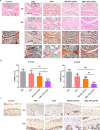MMP-13 enzyme and pH responsive theranostic nanoplatform for osteoarthritis
- PMID: 32854712
- PMCID: PMC7450974
- DOI: 10.1186/s12951-020-00666-7
MMP-13 enzyme and pH responsive theranostic nanoplatform for osteoarthritis
Abstract
Stimulus-responsive therapy permits precise control of therapeutic effect only at lesion of interest, which determines it a promising method for diagnosis and imaging-guided precision therapy. The acid environment and overexpressed matrix metalloproteinases-13 (MMP-13) are typical markers in osteoarthritis (OA), which enables the development of stimulus-responsive drug delivery system with high specificity for OA. We herein demonstrate a nano-micelle based stimuli-responsive theranostic strategy with reporting and drug release controlled by acidic pH and MMP-13 for OA therapy. Such nanoplatform is incorporated with a motif specifically targeting on cartilage, a motif responsive to matrix metalloproteinases-13 to specifically report OA condition and biodynamics of nano-micelles, an anti-inflammatory drug (e.g., psoralidin (PSO)) from traditional Chinese medicine, and a biocompatible polymeric skeleton for sustainable drug release in response to the acidic OA condition. The high effectiveness of this targeted precision therapy is demonstrated comprehensively by both in vitro and vivo evidences.
Keywords: Cartilage targeting; MMP-13/pH sensitive; Osteoarthritis; Theranostics.
Conflict of interest statement
The authors declare no conflict of interest.
Figures








Similar articles
-
Cartilage-targeting and dual MMP-13/pH responsive theranostic nanoprobes for osteoarthritis imaging and precision therapy.Biomaterials. 2019 Dec;225:119520. doi: 10.1016/j.biomaterials.2019.119520. Epub 2019 Sep 24. Biomaterials. 2019. PMID: 31586865
-
Reactive oxygen species (ROS)-responsive nanoprobe for bioimaging and targeting therapy of osteoarthritis.J Nanobiotechnology. 2021 Nov 27;19(1):395. doi: 10.1186/s12951-021-01136-4. J Nanobiotechnology. 2021. PMID: 34838028 Free PMC article.
-
Identification of soluble 14-3-3∊ as a novel subchondral bone mediator involved in cartilage degradation in osteoarthritis.Arthritis Rheum. 2013 Jul;65(7):1831-42. doi: 10.1002/art.37951. Arthritis Rheum. 2013. PMID: 23552998
-
New insights on the MMP-13 regulatory network in the pathogenesis of early osteoarthritis.Arthritis Res Ther. 2017 Nov 10;19(1):248. doi: 10.1186/s13075-017-1454-2. Arthritis Res Ther. 2017. PMID: 29126436 Free PMC article. Review.
-
The role of matrix metalloproteinases in osteoarthritis pathogenesis: An updated review.Life Sci. 2019 Oct 1;234:116786. doi: 10.1016/j.lfs.2019.116786. Epub 2019 Aug 22. Life Sci. 2019. PMID: 31445934 Review.
Cited by
-
Controlled Stimulus-Responsive Delivery Systems for Osteoarthritis Treatment.Int J Mol Sci. 2024 Nov 2;25(21):11799. doi: 10.3390/ijms252111799. Int J Mol Sci. 2024. PMID: 39519350 Free PMC article. Review.
-
Intra-articular nanoparticles based therapies for osteoarthritis and rheumatoid arthritis management.Mater Today Bio. 2023 Feb 26;19:100597. doi: 10.1016/j.mtbio.2023.100597. eCollection 2023 Apr. Mater Today Bio. 2023. PMID: 36910270 Free PMC article.
-
Therapeutic potential of nanotechnology-based approaches in osteoarthritis.Front Pharmacol. 2022 Aug 8;13:920824. doi: 10.3389/fphar.2022.920824. eCollection 2022. Front Pharmacol. 2022. PMID: 36003519 Free PMC article. Review.
-
Biomedical applications of stimuli-responsive nanomaterials.MedComm (2020). 2024 Jul 20;5(8):e643. doi: 10.1002/mco2.643. eCollection 2024 Aug. MedComm (2020). 2024. PMID: 39036340 Free PMC article. Review.
-
Emerging microfluidics-enabled platforms for osteoarthritis management: from benchtop to bedside.Theranostics. 2022 Jan 1;12(2):891-909. doi: 10.7150/thno.62685. eCollection 2022. Theranostics. 2022. PMID: 34976219 Free PMC article. Review.
References
-
- Brown TJ, Laurent UB, Fraser: Turnover of hyaluronan in synovial joints: elimination of labelled hyaluronan from the knee joint of the rabbit. Experimental Physiology 1991, 76. - PubMed
MeSH terms
Substances
Grants and funding
- 2018YFC1105900/National key research and development program of China
- 2018YFC1105900/National Key R&D Program of China
- 81960414/National Natural Science Fund of China
- GuikeAD17129012/the Guangxi Science and Technology Base and Talent Special Project
- GuikeZY18164004/the local Science and Technology Development Project leading by the central government
- 2019KY0134/the Basic ability enhancement project for young and middle-aged teachers of universities in Guangxi
- 2018KY0127/the Basic ability enhancement project for young and middle-aged teachers of universities in Guangxi
- SG2018005/nd the Innovative Project of Postgraduate Majored in Biomedical Engineering
- SG2018007/the Innovative Project of Postgraduate Majored in Biomedical Engineering
LinkOut - more resources
Full Text Sources
Medical

